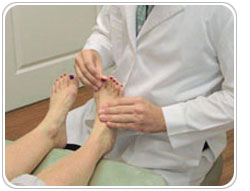|
|
|
Jarrod Shapiro, DPM
Practice Perfect Editor
Assistant Professor,
Dept. of Podiatric Medicine,
Surgery & Biomechanics
College of Podiatric Medicine
Western University of
Health Sciences,
St. Pomona, CA |
Technology abounds. In medicine, we have entered an age in which ultrasounds, MRI, and high resolution CT scanning, among others, have made our ability to diagnose disease that much more accurate. However, with this new technology has also come the loss of something just as important: the physical examination. Increasingly, the movement away from the physical exam has been occurring in the general medical fields, but I've also seen it occurring in podiatric medicine as well. It's time for us to take a small step back and re-examine the role of the physical exam in podiatry.

I'd like to illustrate the point with a short anecdote. Recently my mother experienced an acute onset of left neck and upper back pain. It became so bad that after a few days, she had to go to an emergency room. As is often the case, the pain became unbearable at night after her physician's office hours. She was diagnosed with a muscular back injury (vague if I've ever heard a diagnosis – sort of like "metatarsalgia" for us), prescribed an opiate and muscle relaxant, and asked to follow up with her primary care physician. A day or two later my mother, now slightly high on the opiate but feeling marginally better, saw her primary care physician who ordered an MRI.
The results? A torn rotator cuff.
I asked my mom a seemingly simple question: did anyone examine her?
"Yes," she said. "They checked my heart and made sure I wasn't having a heart attack. They drew blood and found everything to be normal."
Notice what's missing: an actual detailed examination. It turns out neither the ER physician nor her primary care physician (both experienced doctors, not interns or residents) actually examined her back, neck, or shoulder.
My mom was actually surprised that she had a torn rotator cuff. Surprise! It's not like she had a rare shoulder condition. She only had one of the most common injuries affecting the shoulder, much less the human body. A simple physical examination would have diagnosed her shoulder injury. By the way, it took almost a month for her to get the MRI and her diagnosis.
In the medical field, the charge against this loss of the physical examination has been championed by Abraham Verghese, MD of Stanford Medical School. Dr. Verghese, the author of bestselling books My Own Country and Cutting For Stone (which I highly recommend), has written and spoken publically about the loss of the physical exam. For an interesting talk by Dr. Verghese you can see his TED talk here.
Dr. Verghese argues that physicians are treating labs rather than patients, what he terms the "iPatient," and that doctors are not taking advantage of the physical exam as an important ritual that improves holistic patient care (beside the ability to actually diagnose disease). As a result, he and others have pioneered the Stanford 25, a list of important physical exam skills all doctors should possess.
Now, those of us in podiatry might argue that we are specialists, and the physical exam is an integral part of our patient encounter. If that's true, then good for you. Keep up the good work. In reality, though, I see the same trend away from the physical in many corners of our specialty.
For example, I know of a Southern California clinic involved with training podiatric residents that is so busy they have almost no time to perform a physical exam. A patient comes in with an HAV that needs treatment and instead of a physical exam, looking at location of pain, joint movement, reducibility, calluses, etc., has a radiograph ordered and a follow-up appointment made for a preoperative H&P. Where's the ritual? Where's the relationship-building? Where's the intimate knowledge of the patient's disorder?
Maybe it's just this particular program? I doubt it. How many physicians order bone scans or MRIs for patients with suspected osteomyelitis?
Even at my own beloved Western University, we can do better to improve our student's lower extremity physical examinations. We spend, for instance, an inordinate amount of time teaching our students mountains of medical information and how to think through a patient (arguably much more challenging than teaching how to do a vascular examination) and less time on performing a comprehensive physical examination. To remedy this we're now working on creating our own version of the Stanford 25 for podiatry.
I'm concerned that the podiatric lower extremity physical examination will head down the same path as the general medical examination. It would be a sore loss if we all ended up doing a cursory exam in favor of radiographs or advanced imaging. We need to remember as we move into the future that the best tool we have to help our patients is not the MRI but, as Dr. Verghese says, our hands.
Best wishes.

Jarrod Shapiro, DPM
PRESENT Practice Perfect Editor
[email protected]
Get a steady stream of all the NEW PRESENT Podiatry
eLearning by becoming our Face book Fan.
Effective eL earning and a Colleague Network await you. |
 |
This ezine was made possible through the support of our sponsors: |
|